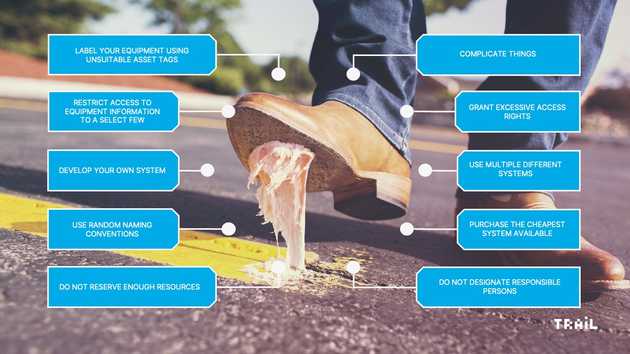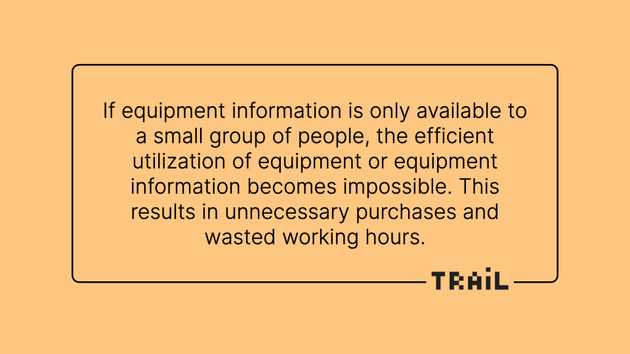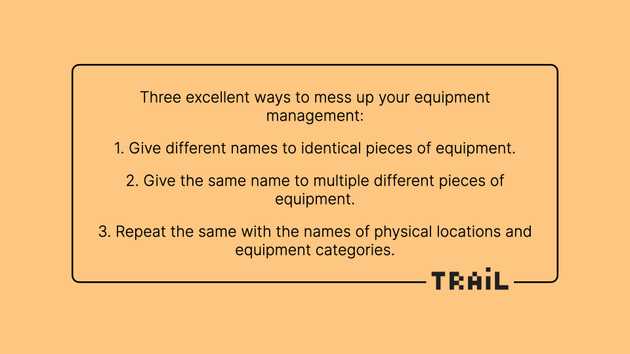We all make mistakes and learn from them. We at Trail have been working with equipment management for over a decade and have made and seen a lot of mistakes.
So, I decided to list the ten most disastrous mistakes in equipment management. Maybe this list will help you to avoid them.
Download whitepaper: Guide to Sustainable Equipment Management
1. Complicate things
Your first fatal mistake is the most important one: making things overly complicated. Over the years, peculiar naming conventions, and complicated processes that are only known by a small group of insiders may have been established in your team or department. They will have to go.
The same golden rule that applies to so many other areas in life is also true for equipment management: Keep it simple. Simple processes and approaches make day-to-day work easier, enable standardization, and speed up the adjustment of new employees.
Therefore, you should not waste time on thinking up complex hierarchies and multi-level location tree solutions. Begin with a system that is as simple as possible.
You should also remember to review your equipment management system with a critical eye from time to time. If unnecessary complexities have found their way into the system, it is time to root them out.
2. Develop your own equipment management system
We have been developing Trail since 2010, and we know extremely well what it takes to develop and maintain an equipment management system. It would be a grave mistake to think that a summer intern could develop a well-functioning system in no time. The truth is that they couldn’t. And even if they could, the odds are that they would not continue to maintain or develop it further. Especially, once they had moved on.
However, if you do choose to develop your own equipment management system, I recommend hiring at least 1–2 full-time software developers to maintain the system. Which means that it would be cheaper to just purchase existing software.
3. Use a number of different systems for different purposes or in different departments
I am sure you can find a dedicated software for any activity. One for maintenance, one for reservations, one for the equipment register, etc.
And each department is, of course, going to want to use the applications that they are already familiar with. This means that the number of different systems just keeps growing.
Working with multiple separate systems, you begin to lose sight of the overall situation and cooperation between departments will be difficult. Therefore, it is important to find the most functional system for equipment management, which offers enough versatility in terms of its features to serve various needs.
4. Restrict access to equipment information to a select few
If equipment information is only available to a small group of people, the efficient utilization of equipment or equipment information becomes impossible. This results in unnecessary purchases and working time wasted on hunting for information and equipment.
A single-system approach also allows you to share equipment information efficiently with all the relevant parties. And it would in fact be vital to allow every member of your organization to easily access equipment information.
By including the option of reporting faults and defects, for example, the responsible persons will become aware of any fault situations more quickly than before.
5. Do not designate responsible persons
Why should you assign the responsibility for your equipment management to anyone? The information is, after all, already stored in the equipment management system.
Sure, the information is stored, but it is unlikely to remain up to date. If you have not designated a person, or preferably persons, responsible for the system, it probably will not see much use. It is particularly important during the implementation of an asset management system that a specific person has been made responsible for it.
The primary duty of the responsible persons is to create a healthy equipment management culture in their organization through example. They make sure that the required processes are created and that the personnel are aware of how the life cycle of equipment should be managed.
Even if you have designated a responsible person, fatal mistakes can still be made. One way to achieve this is to replace the responsible persons as soon they have been trained in the basics of equipment management and use of the equipment management system, for example. This will ensure that the hapless new person in charge of the system has no chance of succeeding in their position.
6. Granting excessive access
The appointment of responsible persons also includes restricting their number. If too many users have excessive access to the system, the results can be disastrous.
From the perspective of equipment management, users mostly just need to be able to view the equipment information and carry out the most common actions easily. These include fault reporting, closing service notes, and making equipment reservations.
It is generally a good idea to allow only a select group of users to carry out such actions as editing the equipment information, adding new equipment items, and removing existing devices. This allows you to ensure the reliability and permanence of the equipment information.
7. Use random naming conventions
Here are three excellent ways to mess up your equipment management:
- Give different names to identical pieces of equipment.
- Give the same name to multiple different pieces of equipment.
- Repeat the same with the names of physical locations and equipment categories.
The easiest way to make a mess of your equipment register while creating or maintaining it is to name the equipment items incorrectly. Typical contributing factors include allowing too many people to edit the equipment information and failing to agree on naming standards.
If different names are given to identical pieces of equipment, it becomes extremely difficult to form an overall view of the amount of equipment on the device level. Similarly, the question “How many of device X do we have?” is difficult to answer quickly if device X is also known as devices Y, Z, and B.
The same is true if you use names that are too imprecise. In this case, the same name is given to multiple devices that are actually different from each other. For example, if all cameras are just named "Camera” regardless of their model, it will be quite difficult for the users to try to reserve a specific type of camera.
Therefore, you should make sure that you have created naming conventions and that those conventions are well-known and fully adopted. The same goes for other objects in the equipment management system, such as locations and device categories.
8. Do not reserve enough resources
Unfortunately, information systems are not yet able to function fully autonomously. This means that manual work is still required in many places.
One good example of this is the equipment information that is entered into the equipment management system. This information is primarily gathered by taking an inventory of your equipment and inputting the results directly into the system or an Excel spreadsheet.
Information can of course be transferred from existing systems to modern equipment management systems through various interfaces. But this would require that the information in the source system is up to date.
The primary point of this is that you are also going to have to reserve personnel resources for equipment management. Modern systems can record equipment life cycle information automatically as the users use the system and send reminders of planned maintenance and late reservations.
But this requires the users to maintain the information by taking inventories and logging maintenance work in the system, for example. You should also label your equipment using unique tags, which will also take up working time.
Luckily, many of these manual tasks only need to be done once during the implementation of the system. In any case, you should still ensure that you have designated a person – or persons – to be responsible for your equipment management from the very start.
9. Label your equipment using unsuitable asset tags
Your equipment should generally be labeled using unique tags. The most common techniques used for this include QR codes, barcodes, RFID, and NFC. And each of these is further divided into various alternative solutions.
Read more: The best asset tags – a guide to RFID, QR code, barcode, and NFC tags
This means that choosing the right tag for your needs is not going to be easy. And that's not all. Using the wrong type of tag is sure to cause some issues.
Therefore, you should take a look at various tags during the implementation of your equipment management system. Identifying your specific needs will help you find the right kind of asset tags. Once your requirements are known, you can work together with specialists to choose the right option for you.
You should therefore make sure that your equipment management system supports all possible tag technologies.
10. Purchase the cheapest system available
The cheapest system may not always be the best. It might be, but the cheaper options tend to lack features you did not think to consider during the purchase but are going to need later.
Price should not be a decisive factor in software selection. It is more important to find a system that offers the best solution to the needs of your organization.
You should also take usability into account. While versatile features tend to add complexity, the development of well-designed systems also takes the user interface into account.
It is still difficult to think of everything during the purchase stage. This is why you should ensure that the development of the system will continue in the future and that it can be customized to your needs where necessary.
Summary
Making mistakes is very human. Often, we learn by making mistakes. So, there is no need to be afraid of mistakes.
Modern equipment management culture is still quite a novel concept. It has not been widely adopted in organizations.
Adopting a new culture and ways of working takes time and requires resources. Mistakes will be made.
The most disastrous mistakes in equipment management are done during its first stages. I mean the time when your organization is still adopting sustainable asset operations.
When you are starting with modern equipment management culture, it is good to rely on a good equipment management system. And remember to ask for help from professionals.
Download whitepaper: Guide to Sustainable Equipment Management


